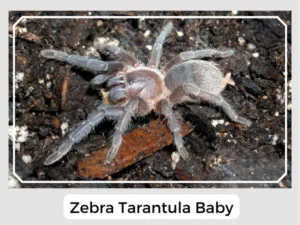Zebra tarantulas are fascinating spiders known for their striking black and white stripes near their leg joints, which resemble zebra patterns. These spiders call Western Costa Rica home and can also be found in other Central American places like Nicaragua, Honduras, and Guatemala.
Between 50 and 2000 eggs are laid and protected with their web. They hatch after a span of 6-8 weeks.
They remain in the burrows for a while after birth and then disperse.

Photo Credit: .BlackCat.
These spiders make dense webs and spend most of their time spinning them. The males on attaining maturity are known to rub their bodies on the web for releasing semen.
Yes, Costa Rican Zebra Tarantulas are venomous, like all tarantulas. However, their venom is generally not harmful to humans and is used to subdue prey.
Yes, they can bite if threatened or provoked. While the bite can be painful due to their large fangs, it’s usually not severe for humans.
Zebra tarantulas contribute significantly to controlling insect populations as they prey on common pests such as cockroaches and grasshoppers. Their webs, which they diligently spin, are not just for capturing prey but also play a role in the dispersal of their eggs.
Natural Predators: Despite their venomous bite, Zebra tarantulas are preyed upon by larger animals, including birds, mammals, and reptiles, which maintain the ecological balance by controlling their population.
Prey-Predator Dynamics: The dynamic between Zebra tarantulas and their prey is a delicate balance. The tarantulas use their venom to subdue their prey effectively, while also having to remain vigilant against predators.
Relationship with Humans: The Costa Rican Zebra Tarantula, also known as the striped-knee tarantula, has a lifespan of around 20 years for females and about 5 years for males. They are found in open areas and semi-arid scrublands where they feed on a variety of insects and small lizards. While they are venomous, their venom is not harmful to humans and their bite, although painful, is not severe.
| Other names | Costa Rican zebra tarantula, striped-knee tarantula |
| Lifespan | Females: Approximately 20 years; Males: 5 years |
| Distribution | Western Costa Rica, alongside other parts of Central America like Guatemala, Nicaragua, and Honduras |
| Habitat | Open areas and semi-arid scrublands |
| Diet | Several insects like cockroaches, small lizards, small beetles, grasshoppers and cricket |
In summary, Zebra tarantulas are essential for pest control in Central America, with a striking appearance and significant human interest.

Zebra tarantulas are fascinating spiders known for their striking black and white stripes near their leg joints, which resemble zebra patterns. These spiders call Western Costa Rica home and can also be found in other Central American places like Nicaragua, Honduras, and Guatemala.
Between 50 and 2000 eggs are laid and protected with their web. They hatch after a span of 6-8 weeks.
They remain in the burrows for a while after birth and then disperse.

Photo Credit: .BlackCat.
These spiders make dense webs and spend most of their time spinning them. The males on attaining maturity are known to rub their bodies on the web for releasing semen.
Yes, Costa Rican Zebra Tarantulas are venomous, like all tarantulas. However, their venom is generally not harmful to humans and is used to subdue prey.
Yes, they can bite if threatened or provoked. While the bite can be painful due to their large fangs, it’s usually not severe for humans.
Zebra tarantulas contribute significantly to controlling insect populations as they prey on common pests such as cockroaches and grasshoppers. Their webs, which they diligently spin, are not just for capturing prey but also play a role in the dispersal of their eggs.
Natural Predators: Despite their venomous bite, Zebra tarantulas are preyed upon by larger animals, including birds, mammals, and reptiles, which maintain the ecological balance by controlling their population.
Prey-Predator Dynamics: The dynamic between Zebra tarantulas and their prey is a delicate balance. The tarantulas use their venom to subdue their prey effectively, while also having to remain vigilant against predators.
Relationship with Humans: The Costa Rican Zebra Tarantula, also known as the striped-knee tarantula, has a lifespan of around 20 years for females and about 5 years for males. They are found in open areas and semi-arid scrublands where they feed on a variety of insects and small lizards. While they are venomous, their venom is not harmful to humans and their bite, although painful, is not severe.
| Other names | Costa Rican zebra tarantula, striped-knee tarantula |
| Lifespan | Females: Approximately 20 years; Males: 5 years |
| Distribution | Western Costa Rica, alongside other parts of Central America like Guatemala, Nicaragua, and Honduras |
| Habitat | Open areas and semi-arid scrublands |
| Diet | Several insects like cockroaches, small lizards, small beetles, grasshoppers and cricket |
In summary, Zebra tarantulas are essential for pest control in Central America, with a striking appearance and significant human interest.
